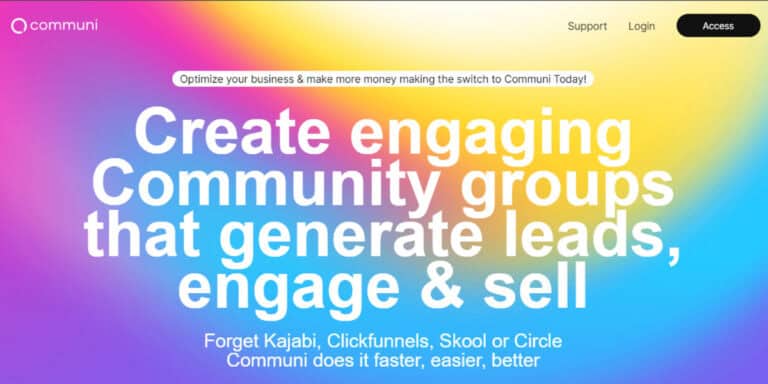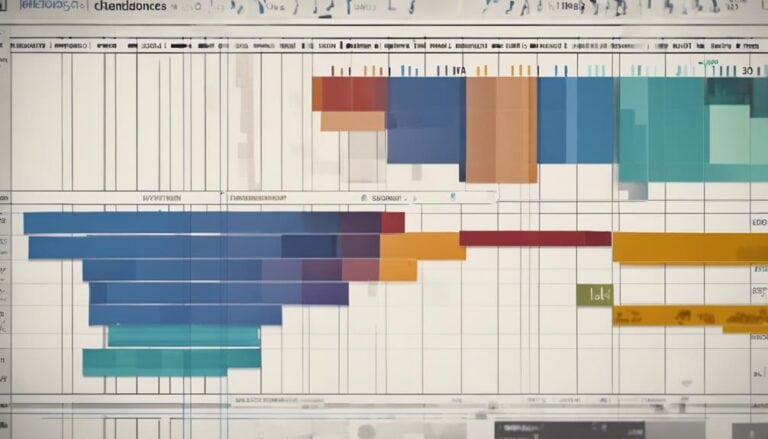When considering project planning methods for small teams, you may find yourself weighing the benefits of various approaches such as Agile, Waterfall, Critical Path Method, Critical Chain Project Management, Six Sigma, among others.
Each method brings a unique perspective and set of advantages to the table, offering tailored solutions for the specific needs of small team projects.
As you navigate through the diverse array of project planning methods, you'll discover key insights that could significantly impact your team's success.
Key Takeaways
- Agile methodologies like Scrum and Kanban optimize project execution for small teams.
- Kanban's visual workflows and work limits enhance productivity and collaboration.
- Scrum's structured sprints and roles ensure iterative development and adaptability.
- Hybrid approaches blend traditional planning with agile methods for small team flexibility.
Agile Project Management Techniques
Explore how Agile project management techniques streamline project execution and enhance adaptability for small teams.
Agile methodologies like Scrum and Kanban offer efficient ways to manage projects by breaking them into manageable chunks and fostering collaboration. Scrum involves cross-functional teams working in short iterations called sprints, allowing for quick adaptations and continuous improvement. This framework promotes iterative development, customer collaboration, and responding to feedback promptly.
On the other hand, Kanban focuses on visualizing workflows and limiting work in progress, aiding in identifying bottlenecks and maintaining a smooth project flow. Both Agile methods emphasize flexibility, making them ideal for dynamic environments and creative projects.
Kanban Methodology for Teams
Originating from Toyota's production system, the Kanban methodology revolutionizes team efficiency and productivity through visualizing work stages on a board. By implementing Kanban in your project management approach, you can benefit from the following:
- Workflow Visualization: Kanban utilizes a board with columns representing different stages of work, providing a clear visual of the project's status.
- Continuous Improvement: Encouraging teams to reflect on their processes regularly and make incremental improvements to enhance productivity.
- Limiting Work in Progress: Focusing on completing tasks before taking on new ones, preventing bottlenecks and improving overall workflow efficiency.
- Enhanced Workflow Transparency: All team members can easily see the status of tasks, promoting collaboration and accountability within small teams.
Utilizing tools like Trello or Jira Software supports the implementation of Kanban boards, making it easier for small teams to manage projects effectively. Kanban's emphasis on visualizing work, continuous improvement, and workflow transparency makes it a valuable method for small team project planning.
Scrum Framework for Small Teams
Building on the principles of the Kanban Methodology, the Scrum Framework offers small teams a structured approach to project management emphasizing iterative development and adaptability.
In Scrum, an Agile project management framework, small teams work in short, time-boxed iterations known as sprints. These sprints enable teams to focus on delivering high-quality work quickly.
Key roles in Scrum include the Product Owner, responsible for maximizing the value of the work done by the Development Team, the Scrum Master, who ensures that the team follows Scrum practices, and the Development Team, responsible for delivering the product increment.
Essential ceremonies in Scrum include daily stand-up meetings for quick updates, sprint planning to outline work, sprint review to showcase the completed work, and sprint retrospective to reflect on ways to improve.
Critical Path Method (CPM) Basics
When beginning to explore Critical Path Method (CPM) Basics, start by understanding the implementation steps and the benefits associated with this project planning technique.
By grasping how to implement CPM and the advantages it offers, you can effectively streamline project processes and optimize resource allocation.
This knowledge will enable you to enhance project efficiency and meet deadlines successfully.
CPM Implementation Steps
To effectively implement the Critical Path Method (CPM) in project planning, begin by breaking down project tasks and identifying their dependencies. This process is crucial for creating a network diagram that visualizes the critical path.
Follow these steps for successful CPM implementation:
- Break down project tasks: Divide the project into smaller, manageable tasks.
- Identify task dependencies: Determine which tasks rely on others for completion.
- Construct a network diagram: Map out the sequence of tasks and their interdependencies.
- Identify the critical path: Highlight the longest sequence of dependent activities with zero slack.
Benefits of CPM
CPM, known as the Critical Path Method, plays a pivotal role in project management by identifying critical and non-critical activities within a project. It's one of the best project management methodologies for small teams working on projects.
By using CPM, teams can effectively schedule and manage project timelines, ensuring tasks are completed on time. This method, supported by solid project management software, helps allocate resources efficiently, addressing any potential challenges that may arise during the project.
CPM focuses on completing key deliverables, making it ideal for small business projects. With CPM, a dedicated project manager can streamline tasks, optimize time management, and enhance overall project success.
Gantt Chart Implementation Tips
You can simplify task timelines and ensure team alignment by following key Gantt chart implementation tips.
By breaking down project tasks into manageable segments represented on the chart, you can streamline workflows and enhance clarity.
Utilize color-coded bars and milestones to visualize progress and dependencies effectively.
Simplify Task Timelines
Implementing Gantt charts in your project planning can significantly streamline task timelines for small teams. By breaking down complex project timelines into manageable tasks, Gantt charts help you plan, schedule, and track tasks efficiently.
Here are some tips for simplifying task timelines using Gantt charts:
- Visualize task dependencies easily.
- Set clear deadlines for each task.
- Monitor progress at a glance.
- Ensure optimal resource allocation for better time management.
Utilizing Gantt charts not only facilitates communication and collaboration but also enhances overall project organization. Stay organized and on track by leveraging the power of Gantt charts for your small team's project planning needs.
Ensure Team Alignment
To ensure optimal team alignment when implementing Gantt charts, utilize color-coding effectively to differentiate task types, deadlines, and team responsibilities. Break down project phases in the Gantt chart to create a clear roadmap for small team members to follow.
Update the Gantt chart regularly using project management software to track progress, identify bottlenecks, and adjust timelines for improved project planning. Share the Gantt chart with team members to ensure everyone is on the same page regarding project milestones, deadlines, and responsibilities.
Lean Project Management Strategies
Lean project management strategies focus on maximizing value and minimizing waste through continuous process improvement. By implementing lean principles, small teams can achieve greater efficiency, reduce costs, and enhance project outcomes.
Here are some key strategies commonly used in lean project management:
- Kanban Boards: Visual tools that help teams manage workflow and limit work in progress.
- Value Stream Mapping: A technique used to analyze and improve the flow of information and materials required to bring a product or service to a customer.
- Continuous Improvement: The ongoing effort to improve products, services, or processes.
- Kaizen Events: Short-term projects aimed at making incremental improvements in a specific area of the project.
Six Sigma Principles for Efficiency
Maximizing efficiency and minimizing waste are key goals when applying Six Sigma principles for project management. Six Sigma methodology, a data-driven approach, focuses on process controls and quality improvement. It follows the DMAIC process – Define, Measure, Analyze, Improve, Control – to optimize projects. For specific needs, variations like Design, Test, Optimize, Verify (DTOV) can be utilized. Six Sigma certification in project management signifies expertise in process improvement.
| Six Sigma Principles | Description |
|---|---|
| Methodology | Focuses on minimizing waste and improving efficiency in project management |
| Data-driven approach | Emphasizes process controls and quality improvement |
| DMAIC process | Defines, Measures, Analyzes, Improves, and Controls project optimization |
| Certification | Recognized as expertise in process improvement in project management |
Waterfall Method for Simplified Planning
Moving from the efficiency-focused Six Sigma principles, the Waterfall method offers a structured and sequential approach for simplified planning in project management. The Waterfall method is a sequential project management approach where tasks are completed in a linear fashion, moving from one phase to the next.
This method involves distinct phases such as initiation, planning, execution, monitoring, and closure, with each phase reliant on the completion of the previous one. It's ideal for projects with well-defined requirements and little need for flexibility or changes during the project lifecycle.
Commonly used in industries like software development, construction, and manufacturing, the Waterfall method ensures a structured approach. However, due to its lack of flexibility, it may not be suitable for projects with evolving requirements or designs.
Hybrid Project Planning Approaches
Hybrid project planning approaches blend elements of traditional and agile methodologies, offering flexibility in adapting to changing project requirements. By combining the structured phases of traditional project planning with the iterative development of agile methods, hybrid approaches provide a tailored approach that suits the evolving needs of small teams. This method allows for detailed planning at the outset while also enabling quick adjustments throughout the project lifecycle.
Small teams can benefit greatly from the flexibility that hybrid project planning offers. They can maintain a level of structure necessary for planning and tracking progress, while also having the agility to make changes as needed. This approach ensures that projects stay on track while being able to adapt to unforeseen circumstances or shifting priorities. Overall, hybrid project planning approaches provide a balanced framework that empowers small teams to effectively manage their projects in a dynamic environment.
Frequently Asked Questions
What Is the Best Project Management Tool for a Small Team?
When choosing collaboration software for small team projects, consider tools like Asana, Monday.com, ClickUp, Trello, and Wrike. They enhance team communication, task tracking, and time management while offering Kanban boards, Gantt charts, and Agile approaches for effective project planning.
What Are the 5 Methodologies?
When planning for small teams, consider utilizing Agile for adaptability, Scrum for teamwork, Kanban for visual tracking, Waterfall for structure, and Lean for efficiency. Incorporate critical path analysis, Gantt charts, risk assessment, stakeholder communication, and time tracking for success.
What Are the Six 6 Types of Project Management Methods?
When managing projects, consider Agile Scrum for flexibility, Waterfall Method for sequential progress. Utilize Critical Path for crucial activities, Lean Project for efficiency. Employ Kanban System for visual workflow, Prince2 Approach for structured management. Opt for Six Sigma for waste reduction, Rapid Application for quick iterations. Choose Extreme Programming for collaboration, Spiral Model for risk management.
What Are the 3 Main Methodologies of Project Management?
When managing projects, remember: Waterfall emphasizes structure, Agile prioritizes adaptability, and Critical Path focuses on essential tasks. Each methodology brings unique benefits and challenges. Tailor your approach to fit your team's needs.
Conclusion
In conclusion, for a small team looking to streamline project planning, consider implementing a hybrid approach that combines elements of Agile and Waterfall methodologies.
By leveraging the flexibility of Agile and the structured stages of Waterfall, your team can adapt to changes quickly while ensuring project milestones are met.
For example, a small software development team successfully utilized a hybrid approach to deliver a high-quality product on time and within budget.
Stay agile, stay organized, and achieve success!





